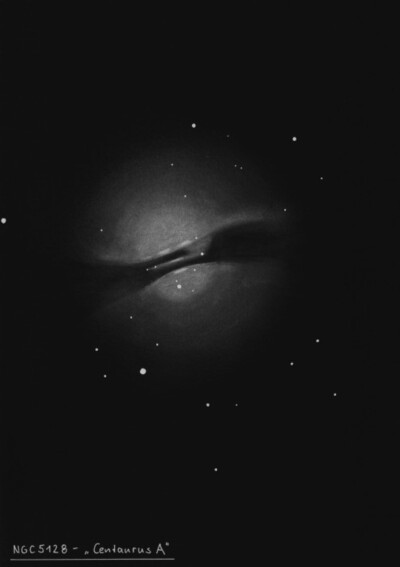Centaurus A
Centaurus A

James Dunlop discovered NGC 5128 = D 482 = Centaurus A = h3501 on 29 Apr 1826 using his 9-inch f/12 homemade speculum reflector from Parramatta (near Sydney). It was discovered on the second night he started recording deep sky objects -- NGC 4945 was discovered just 20 minutes earlier! He reported "A very singular double nebula, about 2.5' long and 1' broad, a little unequal: there is a pretty bright small star in the south extremity of the southernmost of the two, resembling a bright nucleus: the northern and rather smaller nebula is faint in the middle, and has the appearance of a condensation of the nebulous matter near each extremity. These two nebulae are completely distinct from each other, and no connection of the nebulous matters between them. There is a very minute star in the dark space between the preceding extremities of the nebula; they are extended in the parallel of the equator nearly." His sketch (Figure 20) shows two parallel bands with a star between at one end.
John Herschel made several observations: on 1 Jun 1834 he logged "A most wonderful object; a nebula vB; vL; lE; vgmbM; of an elliptic figure, cut away in the middle by a perfectly definite straight cut 40" broad; pos = 120.3 ; dimensions of the nebula 5' by 4'. The internal edges have a gleaming light like the moonlight touching the outline in a transparency." On his next sweep he describing "[Two nebulae, or two portions of one separated by a division or cut.] The cut is broad and sharp. The two nebulae are very nearly alike. Perhaps the slit is larger towards the N.p. end, where there is a star between them. There is certainly a very feeble trace of nebula, an island as it were, running from this star between the sides of the slit." He included a small sketch in a letter written a few days later to his Aunt Caroline (see plate IV, figure 2).
Pietro Baracchi made a detailed observation on 9 Apr 1885 with the Great Melbourne Telescope. He wrote in part "...two very elongated streaks running near one another with their inner edges parallel leaving a channel between them quite dark, about 9' long 50" broad. A very very narrow streak like or string seems to emanate rom a star with the channel towards it n.p. end and run along its axis for about 3'. This narrow streak is very faint. The channel seems to open into a slightly wider spine bounded by much fainter nebulosity into a form a little elongated, irregularly approaching an elliptical shape. But this n.p. end of the channel is not quite closed. It leaves a perfect dark opening in the open n.p. of the object..."
In 1918 Heber Curtis mentioned Cen A as "almost certainly belong to the class of edgewise spirals with dark lane" based on descriptions or sketches, though in 1933 simply classified it as "diffuse. Edwin Hubble, in his 1922 paper "A general study of diffuse galactic nebulae", thought it might be an emission nebula and included it in a table of "Diffuse Nebulae with Emission Spectra", along with M42, the Veil, M8, M16, M17, etc. The Helwan Observatory description from 1921, based on a 30-inch photo from Knox-Shaw, also states "large patch of structureless and possibly gaseous nebulosity.", though no spectrum was taken. The Shapley-Ames catalogue (1932) classified it as an external nebula and in 1947 Harlow Shapley called it as an irregular galaxy.
300/350mm - 13" (4/24/82): wide dust lane bisects galaxy with the southwest hemisphere dominating in terms of size and brightness. A very faint star is at the southwest edge of the dust lane.
400/500mm - 17.5" (3/12/88): bright, large, very large prominent dust lane oriented NW-SE. The SW hemisphere is larger and brighter. A star is superimposed at the south edge of the dust lane (west of center) and a bright star is superimposed on the SW hemisphere (south of center).
600/800mm - 24" (4/11/08 - Magellan Observatory, Australia): I didn't take detailed notes with the 24", but the appearance was mesmerizing at 200x. The equatorial dust lane was more full of contrast and exhibited finer texture and scalloped detail at the edges than I've observed previously in smaller scopes from Australia.
900/1200mm - 48" (4/13/10): at 330x there was a fascinating amount of structure in the wide, equatorial dark lane that bisects the galaxy. The dust lane varied in width with fine structure resolved along its ragged, crenated edge. The interior of the dust lane also varied in brightness with a bright patch close to the center, just following a bright mag 12 star near the south edge of the lane. This patch is elongated with some structure and may be the visible portion of the obscured core. Clouds interrupted this brief observation.
48" (5/9/18): at 610x and 813x; using a DSS2 (Red) finder chart, I easily star hopped over to the globular cluster [VHH81] 7, the first one discovered in NGC 5128 in 1980, starting at the double star HJ 4587 = 9.4/9.5 at 5". I didn't see the see the GC initially at 610x, but bumping the power up to 813x it was identified with certainty about 30" SE of three brighter mag 15-16 stars. The globular (V = 17.2) seemed stellar and was glimpsed for brief moments several times at the same position.
Notes by Steve Gottlieb